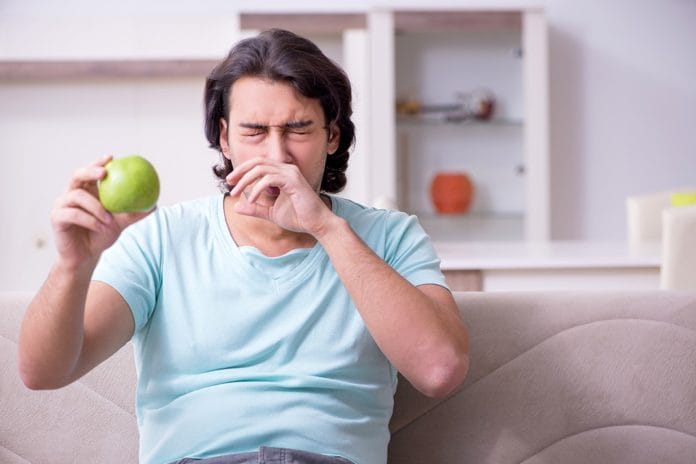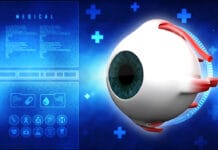Seasonal allergies can be dreadful. Everyone seems to be affected to some degree. Did you know that certain seasonal allergies can cause oral symptoms as well? Patients may not realize the connection or that there is a possibility that their oral symptoms could be linked to certain seasonal allergies. Studies indicate that 20% to 70% of people who suffer from pollen allergies will experience oral allergy syndrome after eating raw fruits and vegetables.1,2
Oral allergy syndrome, also known as pollen fruit syndrome, is an IgE mediated allergic response. Symptoms range from mild itching and the swelling of oral mucosa and lips to rare cases of anaphylaxis. Oral allergy syndrome has been found to be the most common symptom of food allergies. Around 60% of food allergies are contributed to cross-reactions between food and inhaled allergens from certain components of pollen found in trees/weeds and fruit/vegetables/nuts/legumes.
Oral Allergy Syndrome Trigger Foods
This explains the distinct seasonal pattern often seen in this disease.9 All patients with oral allergy syndrome have at least one pollen allergy. Though many foods fall into the pollen categories as possible triggers, patients may only experience symptoms from one food in the category and not necessarily multiple foods.2
Documented pollens and trigger foods include:
- Birch tree pollen sensitivity: apricot, peach, apple, carrots, almond, plum, hazelnut, pear, celery, fennel, parsley, coriander, soybean, carraway, and peanuts.
- Ragweed pollen sensitivity: banana, melon, kiwi, sunflower seeds, squash, and zucchini.
- Grass pollen sensitivity: celery, melons, oranges, peaches, tomato, lentil, peas, potato, and peanuts.2,3,9
- Mugwort pollen sensitivity: banana, parsnips, parsley, chives, celery, carrot, melon and peanuts.4
Although it is not a pollen, I would like to mention that latex allergies are associated with oral allergy syndrome and certain foods. These foods include avocado, citrus fruit, banana, kiwi, grape, mango, papaya, peach, peppers, pineapple, and peanuts.4
Patients generally only have symptoms when these foods are eaten raw. If the foods are cooked, high temperatures break down the proteins responsible for initiating the IgE response. Celery and nuts seem to be an exception though and have been found to still elicit a response after being cooked.
In most cases, patients experience symptoms right after eating raw fruits or vegetables. In rare cases, symptoms may not present for more than an hour later.5,9 Some foods contain antigens that cannot be destroyed by stomach acid, leading to GI symptoms including vomiting, diarrhea, bloating, cramps, and indigestion.9
Oral Allergy Syndrome Diagnosis and Treatment
Diagnosis can be achieved based on clinical and medical history. However, a skin prick test can be done to confirm the suspected allergen.6 Symptoms can usually be managed by avoiding the food that triggers the reaction. Other options include antihistamines and, in severe cases, omalizumab (an anti-inflammatory used to treat asthma and idiopathic urticaria) has been used successfully as an effective preventive treatment.7
Some patients with severe seasonal allergies seek immunotherapy to reduce inflammation associated with these allergies. Patients who receive immunotherapy for seasonal allergies that may be also contributing to their oral allergy syndrome often see long term improvement in both oral symptoms as well as other symptoms associated with seasonal allergies.8
Oral Allergy Syndrome
Oral allergy syndrome often goes undiagnosed or misdiagnosed. Differential diagnosis includes burning mouth syndrome, angioedema, and hay fever. If a patient reports itching, burning, or tingling after consuming certain foods, a thorough review of their health history may show certain comorbidities that can help direct the patient to the right practitioner for proper diagnosis and management. Such comorbidities are hay fever, asthma, and eczema.9
If symptoms concern patients, a referral to an ENT or allergist may help with treatment options and definitive diagnosis. Oral allergy syndrome is often not recognized by clinicians if a patient does not mention concerns since symptoms generally subside after six to 12 hours. If the patient presents without signs of inflammation and does not mention concerns, clinicians will have no indication there may be an underlying problem.
Oral allergy syndrome is rarely life-threatening. However, when a patient presents with concerns and symptoms that could be associated with oral allergy syndrome, clinicians should discuss options to help patients achieve diagnosis and management.
Need CE? Click Here to Check Out the Self-Study CE Courses from Today’s RDH!
Listen to the Today’s RDH Dental Hygiene Podcast Below:
References
- Czarnecka-Operacz, M., Jenerowicz, D., Silny, W. (2008) Oral Allergy Syndrome in Patients with Airborne Pollen Allergy Treated with Specific Immunotherapy. Acta Dermatovenerol Croat. 2008; 16(1): 19-24. Retrieved from https://www.ncbi.nlm.nih.gov/pubmed/18358104
- Muluk, N.B., Cingi, C. Oral Allergy Syndrome. Am J Rhinol. Allergy. 2018 Jan 1;32(1):27-30. Retrieved from https://journals.sagepub.com/doi/full/10.2500/ajra.2018.32.4489?url_ver=Z39.88-2003&rfr_id=ori:rid:crossref.org&rfr_dat=cr_pub%3dpubmed
- Oral Allergy Syndrome. American College of Allergy, Asthma & Immunology. Retrieved from https://acaai.org/allergies/types/food-allergies/types-food-allergy/oral-allergy-syndrome
- Oxford University Hospital NHS Trust. Children’s Allergy Clinic. Oral Allergy Syndrome: Information for Parents. Retrieved from https://www.ouh.nhs.uk/patient-guide/leaflets/files/5537Poralallergy.pdf
- Oral Allergy Syndrome (OAS) or Pollen Fruit Syndrome (PFS). American Academy of Allergy, Asthma & Immunology. Retrieved from https://www.aaaai.org/conditions-and-treatments/library/allergy-library/outdoor-food-allergies-relate
- Sussman, G., Sussman, A., Sussman, D. Oral Allergy Syndrome. CMAJ. 2010 Aug 10; 182(11): 1210-1211. Retrieved from https://www.ncbi.nlm.nih.gov/pmc/articles/PMC2917934/
- Asero, R. Disappearance of Severe Oral Allergy Syndrome Following Omalizumab Treatment. Eur Ann Allergy Clin Immunol. 2017 May; 49(3): 143-144. Retrieved from http://www.eurannallergyimm.com/cont/journals-articles/490/volume-disappearance-severe-oral-allergy-syndrome-1306allasp1.pdf
- Kong, N., Kim, S., Lee, S.C., Park, K.H., Lee, J., Park, J. Subcutaneous Immunotherapy in Patients with Fagales Pollen-Induced Oral Allergy Syndrome. Yonsei Med J. 2019 Apr 1; 60(4): 389-394. Retrieved from https://www.ncbi.nlm.nih.gov/pmc/articles/PMC6433571/
- Kelava, N., Lugovic-Mihic, L., Duvancic, T., Romic, R., Situm, M. Oral Allergy Syndrome – The Need of a Multidisciplinary Approach. Acta Clin Croat. 2014; 53; 210-219. Retrieved from https://pdfs.semanticscholar.org/c08c/f5386ed431cde20a28e8555cc98b7c44de37.pdf?_ga=2.59468138.636749170.1568658717-137117014.1568658717












